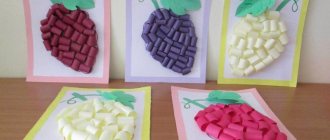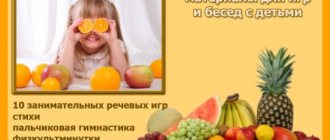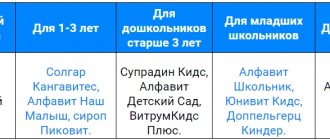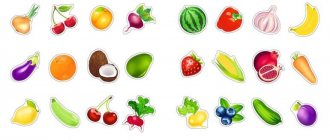Orange.
We bend our fingers one by one.
We shared an orange. There are many of us, but he is alone! This slice is for hedgehogs, This slice is for urchins, This slice is for ducklings, This slice is for kittens. This slice is for the beaver, And for the wolf it is the peel!
Compote.
We depict actions in accordance with the text:
We will cook compote, We need a lot of fruits: We will chop apples, We will chop pears. Squeeze out the lemon juice, drain, and add sand. We cook, we cook compote. Let's treat honest people.
Fruits.
We bend our fingers one by one.
This finger is an orange, He is, of course, not alone. This finger is a plum, delicious, beautiful. This finger is an apricot, growing high on a branch. This finger is a pear, Asks: “Come on, eat it!” This finger is a pineapple, a fruit for you and for us.
Conversation about fruits L.K. Schleger. 1913
Preparing for the conversation.
There are different fruits in front of the children. They name them, determine their shape, colors. Determined by touch and taste with eyes closed.
Catalogs of fruits should be at hand; drawings in paints (that is, color pictures); artificial fruit
Conversation.
What do fruits grow on? What is the name of the tree on which apples grow? Can plums grow on an apple tree? What does a ripe apple look like? What does it taste like? (Sweet, juicy). Who colored the apple so much? What protects the apple pulp? (Skin). When is the apple ripe? The beauty of an apple tree hung with ruddy apples. Has anyone ever seen an apple tree with apples? What are the apples sitting on?
Who can tell me how an apple grows? Is it always so big and ruddy? What color is an unripe apple? What does it taste like? Before the apple appears, the apple tree blooms. When does it bloom? In the spring. Has anyone seen an apple tree in bloom? We'll look at it in the spring, but for now let's look at the picture.
Let's see what's inside the apple , cut it - one lengthwise, the other across. What are the seeds in and how many are there? Why do apple trees need seeds? Why do you need pulp? She guards the seeds. What color are ripe seeds? What about the unripe ones?
What kind of seeds do cherries have? At the plum?
Who eats ripe fruits? Do some people eat and love them? Do people eat seeds? They spit them out. What do birds eat? Seeds fall on the ground, and what grows from them?
What do you sometimes find in apples, pears, plums? Worm. How did the worm get into the apple tree? Does the worm remain in the apple? He gnaws it and comes out (find an apple with a worm in it). A worm is made into a pupa, and a pupa is made into a butterfly.
What do we make from fruits? What do we make jam from? Has anyone ever seen dried fruit? Show and try. What else is made from fruits? Kvass, liqueur.
Do we grow grapes? What do they make from it? What other fruits do you know that grow in warm countries? Oranges, tangerines, lemons. Are the skins of oranges and lemons as thin as those of an apple?
What fruits does an oak tree or a Christmas tree have? Who collects and eats them? Is this fruit?
Children's work on the topic "Fruits".
- Modeling fruits, drawing them.
- Cutting and pasting (applique).
- Cutting out pictures of fruits from catalogs and magazines.
- Illustration “Apple picking”.
- Fruit stand (making a model for children's games together with the children)
Question for educators to consider:
Exactly 100 years have passed since the publication of this conversation for young children by the talented teacher Louise Karlovna Schleger! Have we and our children changed? What is different about the conversation about fruits by L.K. Schleger from modern conversations about fruits in kindergarten? What requirements for a conversation with children were taken into account when compiling this conversation? What would you change about it?
You will learn more about conversations with children and about our history of methods for developing children’s speech from the article “Conversation in kindergarten” based on materials from the book by E.A. Flerina “The Living Word in a Preschool Institution.”
Fun physical education minutes:
Harvest.
Show actions: carry a ladder, set up a ladder, pick pears, put them in boxes, load them into the car.
2. How a gardener grew an apple tree.
Show actions: the gardener digs a hole, plants an apple tree, whitewashes the trunk of the apple tree, waters, fertilizes, prunes, and collects fruits.
3. Apple.
That's an apple! It's full of sweet juice! (stand up, arms to the sides, stretch) Stretch your hands, pick an apple! (hands up, stretch up) The wind began to shake the twig, it’s hard to pick an apple! (arms up, bend to the sides) I’ll jump up, stretch out my hand and quickly pick an apple! (jumping up, clapping overhead)






